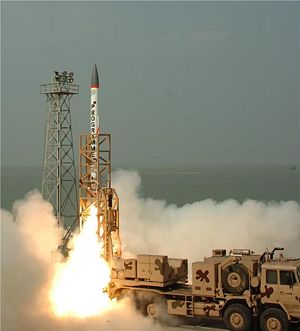A May 15 test of India’s indigenously designed ballistic missile defense (BMD) system was a failure, despite claims to contrary by Defense Research Development Organization (DRDO) scientists, The Hindu reports.
According to unnamed sources, the interceptor missile was never launched from the Integrated Test Range–the Indian military’s primary missile test facility–on Abdul Kalam Island, off the coast of Odisha, on May 15; the incoming nuclear-capable Dhanush ballistic missile merely fell into the Bay of Bengal, with no interception taking place.
“Post-flight analysis is going on. We do not know whether there was problem in detecting the missile, whether radars tracked it and communicated it to the interceptor,” one source told The Hindu. A similar test failed in April 2015 with the interceptor missile plunging into the Bay of Bengal a few seconds after take-off. India has been testing its BMD system repeatedly since 2007.
DRDO initially claimed that a single-stage Ashvin Advanced Defense interceptor missile took off from a mobile launcher at 11:15 a.m. local time on May 15 and successfully destroyed an Dhanush ballistic missile at endo-atmospheric altitudes of 20-40 kilometers (See: “India Successfully Tests Supersonic Interceptor Missile”).
The Dhanush purportedly was launched from an Indian Navy ship in the Bay of Bengal. “The Dhanush is a naval variant of the Prithvi III tactical surface-to-surface short-range ballistic missile and has an approximate range of 350 kilometers (217 miles),” I explained previously.
“The ‘kill’ effect of the interceptor was ascertained by analyzing data from multiple tracking sources,” a DRDO scientist explained after the allegedly successful test on May 15. “The test conducted to validate various parameters of the interceptor in flight mode has been successful,” he claimed.
It is not possible to independently verify either claim at this stage. Interestingly, however, there were no pictures or videos of the May 15 launch or of the interceptor missile in flight published, something which is otherwise regularly done by Indian authorities.
As I reported previously:
India’s BMD shield is a two-tiered defense system with the Prithvi Air Defense (PAD) / Pradyumna Ballistic Missile Interceptor destroying missiles at exo-atmospheric altitudes of 50–80 kilometers (31–50 miles), and the Advanced Air Defense (AAD)/Ashvin Advanced Defense interceptor missile endo-atmosphere at altitudes of 20-40 kilometers (12-24 miles).
The Diplomat explained in 2013:
If the PAD system is devised for mid-course interception, the AAD is a terminal phase interception system which can only counter incoming missiles after their entry into the atmosphere. In their present configuration, these systems are designed to counter missiles with range close to 2,000 kilometers [1242 miles] traveling at speeds ranging from Mach 3 to Mach 8.
The May 15 test also led to strong condemnation from Pakistan, which argued that the test will disturb the balance of power in the region, and that Pakistan has no choice but to acquire advanced military technology and improve its defenses.

































